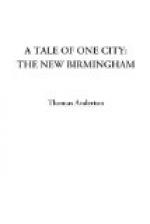Young men who have been to Harrow and Oxford are not likely to look with favour upon suppers of tripe or Welsh rarebits. They must, of course, dine in a proper, decent manner in the evening, and there must be a good experienced cook to give them a fair variety of dainties; or, at least, of well-prepared dishes. Under such circumstances social functions have naturally a tendency to become more formal, ornamental, and refined. Many of the older-fashioned school mourn the decay of the very thorough and hearty hospitality of times back, and have often complained that they saw too many flowers and too little food at modern dinner parties. Still, the knock-down entertainments of our fathers were often a trifle too formidable perhaps, and did not always bring the pleasant reflections that follow the more gentle hospitalities of the present day.
Before I close this chapter, in which I am comparing the present with the past, I cannot help calling to mind features of Birmingham nearly fifty years ago, when I began to look about me with my boyish eyes. I made some general reference to these in the opening chapter of these sketches. I will now just indulge in a few brief details. To go no further than quite the centre of the town, I call to mind some important places that disappeared when the New Street railway station was made.
I remember Lady Huntingdon’s chapel—a place of worship that was popular in its day—and seem to have a hazy recollection of the King Street theatre (or the remains of it), in which was held the first evening concert of the Birmingham Musical Festival in the year 1768. Cannon Street chapel has been too recently removed not to be remembered by many people, but I can recollect going to this place of worship when it was a real old-type Baptist chapel, and where special disciples or devotees were deeply immersed in religion and water.
Most of us can also remember when some unostentatious private houses occupied the side of New Street opposite the Society of Artists’ rooms, and not a few of us can call to mind the dirty, slummy buildings that so closely blocked up the back of the Town Hall. It was, indeed, an improvement when these wretched houses were removed and the back of the Hall was finished and opened out. It is, I believe, true that what became the back of the Town Hall was really intended by the architect to be its front. However this may be, the proportions of the north side of the Town Hall are, I think, more symmetrical and imposing in appearance than the south side fronting Paradise Street.
It is but yesterday, so to speak, since the Old Square, with its sedate looking houses disappeared, including that of Edmund Hector, the friend of Dr. Johnson, and many of us can readily recall to mind the old-fashioned Birmingham Workhouse standing in Lichfield Street—that poor, dirty thoroughfare which doubtless furnished a fair number of occupants for the afore-mentioned institution. Looking forward as I do—at least in my sombre moments—to the “Union” as being my ultimate home, I feel a sense of satisfaction that the Birmingham workhouse has been removed to a more salubrious and pleasant locality than its unlovely quarters in Lichfield Street.




